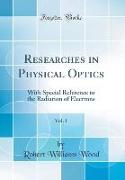- Start
- Researches in Physical Optics, Vol. 1
Researches in Physical Optics, Vol. 1
Angebote / Angebote:
Excerpt from Researches in Physical Optics, Vol. 1: With Special Reference to the Radiation of ElectronsAmong the more remarkable of the new phenomena may be mentioned the striking circumstance that if the iodine vapor exists in an atmosphere of helium at a pressure of only 2 or 3 mm. Instead of in a high vacuum, the complete band spectum, very similar to that excited by white light, appears in addition to the resonance spectrum, while at a pressure of 8 or 10 mm. The resonance spectrum disappears entirely and is replaced by the band spectrum. This remarkable effect of molecular collisions was studied in collaboration with J. Franck early in year 1911, and has been the subject of further study during the year follow ing. The circumstance that the light making up the resonance spectra was partially polarized also came to light, and gives us important additional information as to what is going on within the radiating molecule. In the course of a very extended study of resonance spectra with which I have been engaged Off and on for the past seven years, I have come to the conclusion that no very great advance could be made until some method was devised for varying the wave-length of the exciting light by very small amounts.In the previous work the spectra excited by a large number of widely separated wave-lengths have been studied, but no very general conclusion as to the nature of the molecular mechanism could be drawn from the accumulated material.During the past winter I have advanced a step in the right direction and have made a very good beginning on the work which I have always hoped would be possible.Some very astonishing results have been obtained, which throw a good deal of light on certain points which I never felt able to explain in the course of the work on sodium vapor.I have found, for example, that the resonance spectrum of iodine is quite different when excited by the green line of the cooper-hewitt mercury lamp (commercial glass lamp) from the resonance spectrum excited by the same line from the mercury are in quartz (high temperature are), in other words the resonance spectrum suffers profound changes when small changes occur in the structure of the exciting line. In all of the previous work I have assumed that only one of the hundreds of absorption lines was operated upon by the exciting line, though in one or two cases I ventured the hypothesis that the exciting line might be broad enough to act upon two absorption lines simultaneously (see paper by R. W. Wood and F. E. Hackett on the reso nance spectra of sodium photographed with the concave grating, Astro-physical Journal.About the PublisherForgotten Books publishes hundreds of thousands of rare and classic books. Find more at www.forgottenbooks.comThis book is a reproduction of an important historical work. Forgotten Books uses state-of-the-art technology to digitally reconstruct the work, preserving the original format whilst repairing imperfections present in the aged copy. In rare cases, an imperfection in the original, such as a blemish or missing page, may be replicated in our edition. We do, however, repair the vast majority of imperfections successfully, any imperfections that remain are intentionally left to preserve the state of such historical works.
Folgt in ca. 10 Arbeitstagen

